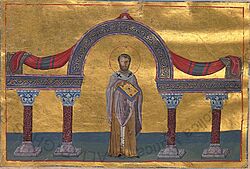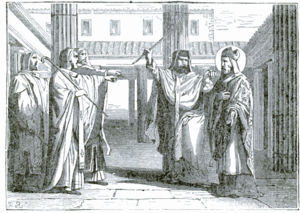Flavian of Constantinople facts for kids
Quick facts for kids SaintFlavian of Constantinople |
|
|---|---|

Saint Flavian, as depicted in the 11th century Menologion of Basil II.
|
|
| Patriarch of Constantinople, Martyr | |
| Died | 449 Hypaepa, Lydia, Asia Minor |
| Venerated in | Eastern Orthodox Church Catholic Church |
| Canonized | 451 by Council of Chalcedon |
| Major shrine | Relics venerated in Italy |
| Feast | February 18 |
Flavian (died August 11, 449) was an important church leader. He served as the Archbishop of Constantinople from 446 to 449. Today, he is honored as a saint and a martyr (someone who died for their beliefs) by both the Eastern Orthodox Church and the Catholic Church.
Contents
Becoming Archbishop of Constantinople
Flavian was a respected priest and cared for the holy items of the great Church of Constantinople. People believed he lived a very saintly life. Because of this, he was chosen to become the new Archbishop of Constantinople. He took over from a leader named Proclus.
During his special ceremony to become archbishop, the Roman Emperor Theodosius II was nearby. A powerful official in the emperor's court, named Chrysaphius, tried to get money from Flavian for the emperor. When Flavian did not give the money, Chrysaphius started to work against him. He supported a monk named Eutyches, who was having a disagreement with Flavian.
The Council in Constantinople
Flavian led a meeting of forty bishops in Constantinople on November 8, 448. This meeting, called a synod, was held to settle a problem between two church leaders. During this meeting, a bishop named Eusebius accused Eutyches of teaching wrong ideas about faith.
Flavian spoke to Eusebius, asking him to talk with Eutyches first. He said, "Please visit him and discuss the true faith." Flavian added that if Eutyches was truly wrong, he would be called to the meeting to explain himself. In the end, the synod decided that Eutyches' teachings were incorrect and removed him from his position.
The Second Council of Ephesus
Eutyches did not agree with the decision and got support from Pope Dioscorus I of Alexandria. He went to Alexandria for help. Emperor Theodosius II was already upset with Flavian for not giving him money. Chrysaphius convinced the emperor to call another big church meeting.
This new meeting, called the Second Council of Ephesus, took place on August 8, 449. At this council, Eutyches was declared to be teaching the correct faith and was put back in his position. Flavian, however, was strongly criticized, removed from his role, and ordered to leave the city.
Flavian's Death and Martyrdom
At the Second Council of Ephesus, leaders who disagreed with Eutyches' ideas faced many challenges. Flavian refused to change his beliefs. Because of this, Dioscorus and some monks, led by Barsumas, attacked him. Flavian was beaten, kicked, and trampled.
He suffered from his injuries for three days. Flavian died in a place called Epipus in Lydia. He was buried quietly, without much ceremony.
What Happened Next
Pope Leo I, whose representatives were ignored at the council, protested strongly. He called the council a "robber synod" because he felt it was unfair. He declared that all its decisions were invalid.
After Emperor Theodosius II died in 450, his sister Pulcheria became powerful again. She married Marcian, who then became the new Emperor. The new emperor and empress arranged for Flavian's body to be brought back to Constantinople. A writer at the time said it looked more like a victory parade than a funeral.
In 451, another important meeting, the Council of Chalcedon, was held. This council decided that Eutyches' teachings were wrong. It also confirmed Pope Leo's letter about faith and declared Flavian a martyr (a saint who died for their faith).
In the Roman Catholic Church, Saint Flavian is remembered on February 18.
See also
- In Spanish: Flaviano de Constantinopla para niños
- St Fravitta of Constantinople, sometimes called Flavian or Flavianus II.


